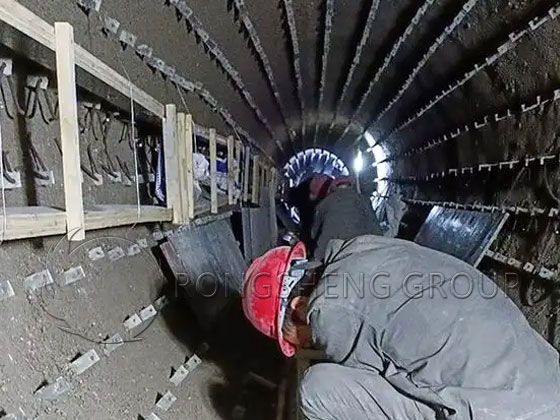After the castable begins to set, the curing time must be at least 24 hours at room temperature. To some extent, extending the curing time to 48 hours or longer will help increase the strength of the concrete. For low-cement castables, the setting time is often longer.
Curing of Rotary Kiln Lining Castables
For areas using high-strength castables, such as coal injection pipes and kiln openings, the curing and demolding times should be appropriately extended. Before hardening, moisture evaporation should be prevented. Treatments such as covering the lining surface with a thin layer of plastic or grass matting, or applying mud and water for curing, can be employed. During this period, due to the low strength of the concrete, excessive mechanical forces that could damage the concrete should be avoided. After hardening, the castable should be allowed to dry for a period of 24 to 48 hours at an ambient temperature of 15 to 30°C. The lower the temperature, the longer the curing time. If the temperature falls below 10°C, consider increasing the temperature to improve curing conditions. Sodium silicate and phosphate castables should be cured in a dry environment, utilizing the dehydration of the sodium silicate to increase strength. Avoid watering during curing. Demolding time should be appropriately selected. Non-load-bearing formwork should be demolded when the castable strength is sufficient to prevent it from falling apart due to cold. Load-bearing castables should be demolded when the strength reaches 70%. The core mold with higher strength should be demoulded in time without causing damage to the concrete, so as to avoid difficulty in demoulding due to excessive strength of the castable.

Drying and Heating the Preheater and Precalciner Systems
After hardening or drying, the castable still contains residual physical and chemical water. This water must be removed by heating it to 300°C for gasification and dehydration. Due to the dense structure of the castable, the heating rate must be slow to avoid damage to the castable caused by stress due to rapid temperature increases and excessive evaporation of water. The kiln system’s drying and heating schedule may not always meet the drying requirements of the preheater and precalciner (the grate cooler, kiln head hood, and tertiary air duct meet the kiln system’s drying and heating schedule and are not listed separately). Therefore, the kiln system’s baking and heating schedule, described below, should be implemented in conjunction with the requirements of this section.
If the primary preheater fails to meet the drying requirements when the kiln system reaches 600°C (based on the kiln exhaust gas temperature), the kiln system’s holding time at 600°C should be extended. The final batch of refractory castables should be cured at approximately 25°C for at least 24 hours (for low-cement castables, the curing time should be extended to 48 hours, if appropriate). After the castable has achieved a certain strength, the formwork and supports are removed.
After drying for 24 hours, the curing process can begin. If the curing temperature is too low, the curing time will need to be extended. Based on the kiln exhaust gas temperature, increase the temperature at a rate of 15°C/hour until it reaches 200°C, holding it for 12 hours. Increase the temperature at a rate of 25°C/hour to 400°C, holding it for at least 6 hours. Increase the temperature to 600°C, holding it for at least 6 hours.
The following two conditions are necessary and sufficient for the bakeout of the decomposition furnace and preheater systems:
When the temperature of the refractory castable at the cyclone preheater pouring hole, on the side closest to the silicon cover plate, reaches 100°C, continue drying for at least 24 hours.
At the manhole door of the first-stage cyclone preheater, contact the flue gas with a clean piece of glass. If no moisture condensation on the glass is observed, hold it for 6 hours.
Curing and Curing Time for Refractory Castables
The curing and curing time for refractory castables are affected by a variety of factors. The following is a guide to common curing times:
Regular Curing Time
- Formwork Curing: After pouring, the castable generally requires 24 hours of formwork curing before demolding.
- Post-Demolding Curing: A 24-hour natural curing period is ideal after demolding. This allows the castable to reach a certain strength and avoid premature disturbance.
Adjustments for Special Situations
- Low-cement castables: Curing requirements are higher, and curing time may need to be extended to 48 hours or even longer, depending on the material properties.
- Winter Construction: When the ambient temperature is below 5°C, insulation measures (such as steam curing or electric heating) are required. Curing time may be extended to 48-72 hours to ensure sufficient curing of the castable.
- High Temperature Environment: When the ambient temperature is above 30°C, moisture-retention curing is required to prevent rapid evaporation of moisture, which could affect strength. Curing time is generally no less than 24 hours.
Curing Precautions
- During curing, maintain the ambient temperature between 15-35°C and avoid sudden temperature fluctuations.
- Cement-bonded castables require moist curing, while waterglass or phosphate-bonded castables should be cured in a dry environment and avoid watering.
- During curing, avoid striking or vibrating the castable to prevent cracking.
The curing and curing time for common refractory castables at room temperature (10-30°C) is generally around 48 hours, but the specific time varies depending on factors such as material type, ambient temperature, and construction process. During construction, strictly follow the material specifications and construction specifications to ensure that curing conditions meet standards and guarantee the performance and service life of the castable.

